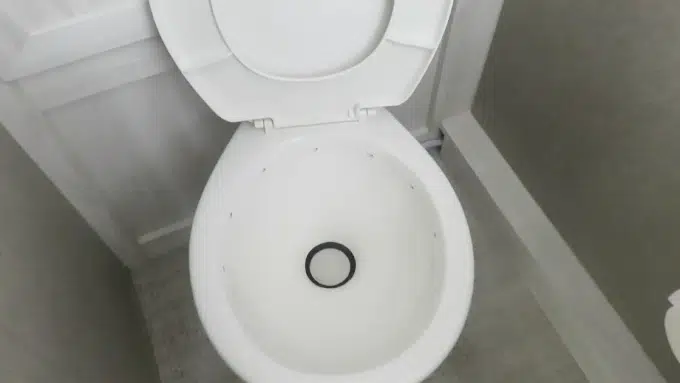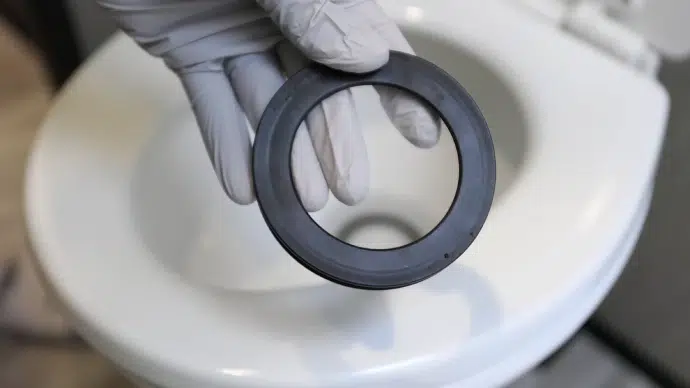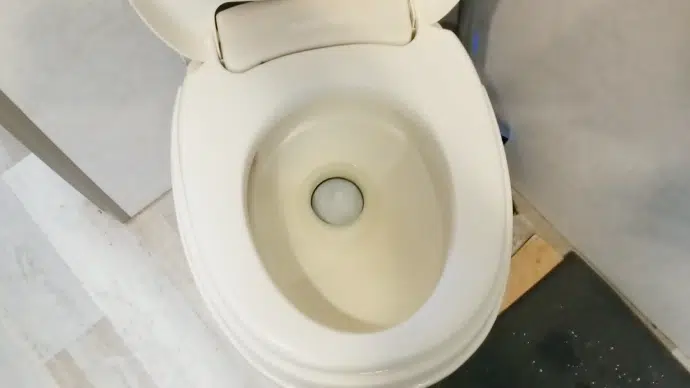Last Updated on April 20, 2023
Many RV enthusiasts wonder if they can use the toilet while driving when planning a road trip, but the answer isn’t always clear-cut.
It is technically possible to use the toilet while driving an RV. However, several important factors are essential, such as size and weight, water consumption, tank capacity, etc.
We will discuss the safety, legal, and waste management aspects of using an RV toilet. After reading this post, you’ll know if using the toilet while driving is a good idea and how to make it a comfortable and stress-free experience. Discover more profound knowledge through reading.
Can You Use Toilet in RV While Driving: Is it Possible?
Many first-time RVers ponder the possibility of using their vehicle’s bathroom while on a road trip. The answer is far from straightforward and needs to be thoroughly examined based on various factors.
Safety Considerations
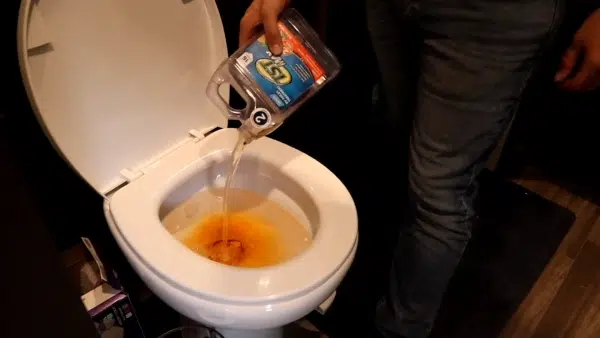
Using the toilet while driving an RV should always be a safety priority. It is important to remember that an RV is a moving vehicle, and sudden movements or stops can occur at any time, creating an unsafe bathroom environment.
Using the restroom before hitting the road is recommended to avoid accidents or injuries. This will reduce the need for frequent stops and minimize the risk of using the toilet while driving. Additionally, limiting water usage can help prevent spills or overflow during transit.
Another safety consideration is the type of toilet installed in your RV. There are three main types: gravity flush toilets, vacuum flush toilets, and composting toilets.
Gravity flush toilets rely on gravity to move waste into a holding tank, while vacuum flush toilets use suction to remove waste. Composting toilets use natural processes to break down waste into compost.
It is important to secure your toilet paper as well properly. Loose items can become projectiles during sudden movements or stops, potentially causing harm or damage. Planning your route ahead of time can also help you avoid bumpy roads or sharp turns that could lead to spills or accidents.
Lastly, it is important to be aware of the legalities and regulations regarding waste management while driving an RV. Some states may have specific laws regarding dumping waste on highways or require certain waste disposal systems.
Considerations for Choosing a Toilet While Driving
The size and weight of the toilet are essential factors to consider, as you want something lightweight and easy to maneuver while on the road.
Additionally, you should consider water usage, tank capacity, maintenance, and cleanliness.
Size and Weight
Size and weight are important considerations when choosing an RV toilet for driving. You want a lightweight, compact toilet to fit in your vehicle without too much space.
Some of the best options for RV toilets that are easy to transport while driving include cassette toilets and composting toilets. Cassette toilets are self-contained units with a removable waste tank that can be emptied at any dump station.
They are typically small and lightweight, making them ideal for use in RVs on the go. Composting toilets, on the other hand, decompose waste using natural processes, which can be safely disposed of later. These types of toilets are also compact and lightweight, making them a popular choice for RVs.
When considering size and weight, it’s also important to consider how many people will be using the toilet and how often it needs emptying or cleaning. A more prominent family may require a giant toilet with a more significant waste tank capacity, while smaller groups may get by with something more compact.
Water Usage and Tank Capacity
Choosing an RV toilet that is suitable for driving, water usage, and tank capacity are essential factors. You want a toilet that can handle your needs without constant refilling or emptying.
Gravity flush toilets are the most common type of RV toilet and typically use 1-2 gallons of water per flush. They have a large holding tank that can hold up to several days’ worth of waste before needing to be emptied. However, this also means they can be heavy and take up more space in your RV.
Macerating toilets grind the waste into smaller pieces before flushing, reducing the water needed per flush. They also have a smaller holding tank than gravity flush toilets, which makes them lighter and more compact. However, they require more maintenance due to their complex design.
Cassette toilets have detachable waste tanks that can be easily and quickly emptied at any dump station. They use less water than gravity flush toilets but require more frequent emptying since their tanks are smaller. Cassette toilets are a good option for those who want a lightweight and easy-to-maintain toilet.
Composting toilets do not use any water and instead rely on the natural breakdown of waste to generate compost. This makes them ideal for those who want an eco-friendly option that doesn’t require any plumbing or electricity.
However, composting toilets require regular maintenance to ensure proper decomposition.
When considering water usage and tank capacity while driving, choosing an RV toilet that fits your needs without being too bulky or heavy is essential. Consider how often you’ll need to refill or empty the tank and how much space you have available in your RV for the toilet itself and its associated components.
Maintenance and Cleanliness
Maintaining cleanliness in your RV toilet is crucial for a comfortable and hygienic trip. Choosing a toilet that is easy to clean and maintain is essential.
When it comes to cleaning, the type of toilet you choose will play a significant role. For instance, composting toilets require more maintenance than other RV toilet types. They require regular emptying of the compost bin and cleaning of the urine diverter.
On the other hand, cassette toilets are relatively easy to clean and maintain. They have removable waste tanks that can be quickly emptied and cleaned. These tanks can be carried to a dump station or bathroom for disposal.
For gravity flush toilets, cleaning is quite simple as they use gravity to flush waste into the black tank. However, you must ensure enough water in the bowl during use to avoid clogs or stains.
Finally, macerating toilets are also easy to clean since they have a self-cleaning feature that rinses the bowl after each use. However, you need to ensure that no foreign objects, such as wipes or feminine products, are flushed down this type of toilet as they may cause clogs.
Apart from the type of toilet, other factors affect cleanliness and maintenance, such as proper ventilation in the bathroom area, using appropriate chemicals for odor control, and ensuring proper seals between the toilet components.
Legalities and Regulations

It is important to note that laws regarding this issue vary by state or country, so it is always best to check with local authorities before hitting the road.
In general, most states and countries require that all passengers be seated and wearing seat belts while the vehicle is in motion. This means that if you have a built-in toilet in your RV, using it while driving is likely, not legal.
However, suppose you have a portable or cassette toilet that can be easily removed from its holder and used elsewhere in the RV. Using it while the vehicle is moving may be permissible in that case.
It’s important to note that even if using a portable or cassette toilet while driving is legal, it may not be safe. The vehicle’s movement can cause spills or accidents, which could result in serious injury. As such, it’s recommended that you only use these types of toilets when necessary and when parked safely off the road.
Another consideration when using an RV toilet while driving is waste management. Some areas have strict regulations about how waste must be disposed of, so planning and knowing where to dump your waste legally is essential. Also, proper hygiene practices should always be followed when using any RV toilet.
Tips for Managing Waste While Driving
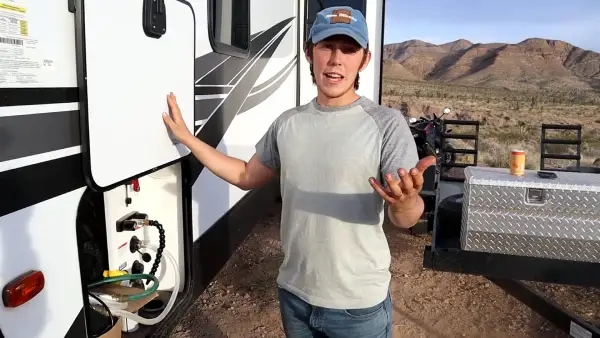
You need to remember a few tips when using an RV toilet while driving. Here are some useful tips:
Use the Restroom Before Hitting the Road
One of the essential tips for managing waste while driving an RV is to utilize the restroom prior to driving. This may seem obvious, but ensuring you don’t have to use the toilet while driving is crucial.
Using the restroom before your journey can help prevent accidents and make your trip more comfortable. Remembering everyone in your group to use the restroom before leaving is also a good idea, especially if you’re traveling with children or elderly individuals.
Limit Water Usage
When driving an RV, it is essential to be mindful of how much water you use in your toilet. Excess water can cause the tank to fill up quickly and potentially overflow, creating a mess and a health hazard.
To limit water usage while driving, consider using a low-flow toilet or installing a water-saving device on your current toilet. These devices can help reduce the water used with each flush, ultimately extending the time between tank dumps.
Another way to limit water usage is by being conscious of how much water you use when flushing. Instead of holding down the flush lever for an extended period, simply press it briefly to release enough water to clear waste from the bowl.
Additionally, avoid flushing anything other than human waste and toilet paper down the toilet, as this can contribute to excess tank buildup.
Properly Secure Your Toilet Paper
To prevent any mess or inconvenience, make sure your toilet paper is properly secured in an RV. The last thing you want is for loose toilet paper to fly around the vehicle while driving.
To avoid this, you can use several methods to ensure your toilet paper stays put. One option is to use a wall-mounted dispenser that securely holds the roll. This keeps the paper from flying around and makes it easily accessible when needed.
Another option is to store your toilet paper in a plastic container with a lid. This will keep it contained and prevent it from getting wet or dirty on the road. Additionally, you can use a bungee cord or strap to secure the container to a nearby surface so it doesn’t move around during transit.
It’s also important to consider the type of toilet paper you’re using. Some brands may be too thin or flimsy and can easily tear apart during use or transport. Look for thicker, more durable options that will hold up better.
Properly securing your toilet paper can avoid any potential messes and make your RV trip more enjoyable and stress-free.
Plan Your Route
Planning your route is key to using the restroom while driving an RV. Planning and knowing where rest stops or other facilities are located along your route is essential. This will allow you to take necessary breaks and use restroom facilities as needed.
When planning your route, consider the length of your trip and how often you may need to stop for bathroom breaks. If you have a larger RV with a bathroom onboard, you may be able to go longer between stops.
However, you may need to plan for more frequent stops if you have a smaller RV or camper van without a built-in bathroom.
It’s also important to consider the terrain of your route. If you’re traveling through mountainous regions or areas with winding roads, finding suitable places to stop and use the restroom may be more difficult.
In these cases, it’s best to plan ahead and know where rest areas or other facilities are located before setting out on your trip.
What happens when you flush a toilet in an RV while driving?
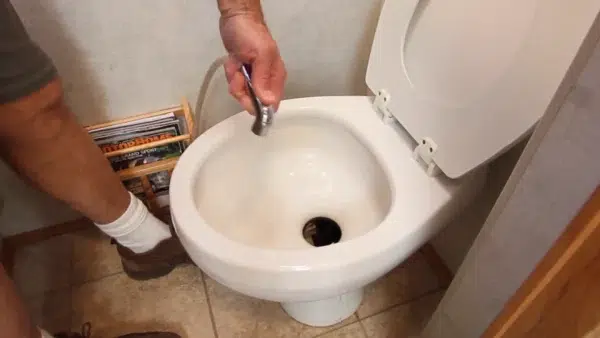
While flushing the toilet in an RV while driving, it is important to turn the water pump on, use stabilization tools, and control your body mass to avoid accidents. While it is legal to use the bathroom in Class A or C RV while driving, it is illegal to ride in a towable while in motion.
How often should you empty your RV toilet?
To maintain your RV toilet, it is recommended to empty it when it’s about 2/3 to 3/4 full or at least once a week depending on the number of people using it. Flushing the toilet when dumping helps keep the tank and sensors cleaner, and using dissolvable toilet paper is also recommended.
RV toilets come in different types, including the common type with a water supply, foot pedal, and black tank, premium porcelain, affordable plastic models, and cassette toilets for smaller RVs.
How many gallons does an RV toilet use per flush?
The amount of water used per flush in an RV toilet varies depending on the type of toilet and user behavior.
Gravity-flush RV toilets use an average of 0.75 to 1 gallon per flush, with a recommended usage of 16 ounces for liquid waste and 1 gallon for solid waste. Low-flow RV toilets use 16-20 fluid ounces per flush. It is important to consider toilet type and water usage for efficient water management on RV trips.
Have an Optimal RV Trip with Careful Planning & Preparation
When you’re driving an RV, using the toilet can be a great way to enjoy all the comforts at home without staying put. With careful planning and preparation, you can ensure your next road trip is worry-free and comfortable for all passengers.
From choosing the right type of RV toilet, limiting water usage, and properly managing waste disposal, you can ensure a stress-free journey ahead by following these tips. So what are you waiting for? Get out there and explore.

